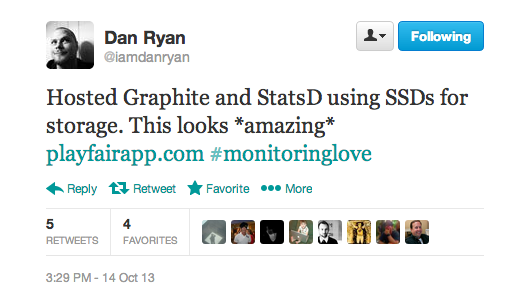Graphite Tip - Django 1.4 Admin Workaround
2014-01-05 00:39:38 by jdixon
If you're using Graphite with Django 1.4 or newer, you've probably noticed the broken styling on the Admin module. This appears to be an annoyance at worst, but it's ugly nonetheless. I don't have a fix for this yet, but I have a workaround for anyone using Apache with their Graphite web UI.
- Comments (5)
Graphite Tip - Working with Carbonate
2014-01-02 20:29:59 by jdixon
One of my friends at GitHub, Scott Sanders, recently published a new suite of tools collectively known as Carbonate. Anyone who has had the "pleasure" of migrating Graphite to one or more new servers, in production, has likely felt the pain of dealing with gaps in your time-series data. This is a common source of pain for many administrators; I'm really pleased that Scott was able to put together this collection of shell primitives for managing Whisper migrations.
- Comments (4)
Migrating Graphite from SQLite to PostgreSQL
2013-12-14 19:29:20 by jdixon
As mentioned in my previous article, I no longer recommend using SQLite as a Graphite backend for anything outside of development or testing work. It is too lenient with data types, and doesn't provide the levels of concurrency I'd like to see in an RDBMS for a production web service.
This opinion was cultivated almost exclusively from my recent experience migrating a single-node Graphite instance with an SQLite database to an HA pair of Graphite nodes with a shared PostgreSQL backend. For those of you considering migrating off SQLite to PostgreSQL, this article documents my initial struggles and eventual fixes for this transition.
- Comments (4)
Why You Shouldn't use SQLite with Graphite
2013-12-10 19:44:07 by jdixon
If you've ever had the pleasure of installing Graphite, you're almost certainly aware that it uses Django as it's web framework. In order to support features like saving graphs and dashboards, Graphite needs somewhere to store the data that describes these objects. As you might expect, a relational database with support for SQL is a dandy place for this sort of relational data. Django supports a number of RDBMS backends using the Django ORM, making it relatively painless to get started with Graphite in a development or test environment using the popular SQLite database engine.
- Comments (0)
My Impressions of InfluxDB
2013-11-11 12:15:38 by jdixon
I mentioned last week that I was planning to look closer at InfluxDB this past weekend, and some folks asked me to do a writeup on my findings.
InfluxDB is a time-series metrics and events database based on the LevelDB key-value store. LevelDB was written and open sourced by Google, and is an optional backend for Riak. InfluxDB (or "Influx", for short) inherits many of LevelDB's default characteristics, which means it's optimized for writes and uses compression by default, but it can be slow for reads and deletes.
- Comments (9)
What's Up with Playfair?
2013-10-19 02:58:37 by jdixon
Within the last hour I stumbled across a tweet from Dan Ryan mentioning a new hosted Graphite + StatsD service called Playfair. As you might expect, this piqued my interest.

Immediately, I thought of Hosted Graphite and wondered how this compares with their offering. Would it have its own dashboard? Was it a DigitalOcean-backed Graphite instance (admittedly, something I've considered trying to package up myself)? I hopped over to their website and looked around.
- Comments (1)
Graphite Tip - Mixing Lines and Stacks
2013-08-16 13:43:15 by jdixon
One of Graphite's shortcomings is that it's not easy to construct a composite chart of both lines and area sections. In fact, it's not possible at all unless you're willing to stack your areas. But if you are dealing with data where it makes sense to stack them, and you want to correlate that with something else as a line series, here's an example demonstrating how you can do it.
- Comments (1)
Are We Ready to Kill Thresholds?
2013-06-26 09:12:54 by jdixon
I've been hearing a lot of chatter from various sources that adaptive fault detection is going to be The New Shit ™ and that static thresholds are virtually useless because they lack context. While I agree that some of the more advanced techniques sound amazing (and make no mistake, I'm really excited about the possibilities here), it's foolish to think that thresholds as a measure of fault conditions are useless.
- Comments (3)
Dusk - Yet Another Graphite Dashboard
2013-06-21 19:36:28 by jdixon
Not too long ago we were looking for a way to visualize a group of metrics across our entire fleet. Although you could render all of the metrics on one graph, it becomes nearly impossible to distinguish one from another. Jesse Newland (@jnewland) suggested that we look at Cubism.js' horizon charts. The nice thing about horizon charts is that you can cram a lot of information into a small vertical space, due to the way they render "overlapping" values with increasing intensity. One thing led to another, and soon Dusk was born.
- Comments (6)
Call for OSS Project Instrumentation
2013-05-28 09:56:28 by jdixon
As an open source developer, some portion of my time is spent not just coding and responding to user feedback, but to act as a Project-slash-Product Manager. I have to determine which bugs to prioritize, which features are necessary, and where to allocate my finite resources. Much of this is driven by what interests me at the time and which features will best fit into my overarching vision for the project.
- Comments (2)

 RSS 1.0
RSS 1.0